Artificer
Artificers are the practical technicians of the magical world. Unlike wizards or sorcerers who pursue more theoretical research, or clerics and druids who are tied to the mandates of their deities or churches, artificers take the practice of magic and tailor it to the needs of the situation. From maintaining complex enchantments along lightning rail lines or on board an elemental airship, to customizing the combat enchantments from a strike team deep behind enemy lines, artificers take the magic that is already at hand and applies in a more efficient manner, essentially getting more spell for the silver.
Role: An artificer takes on the role of a magical item expert, providing much of the flexibility as a wizard, the critical eye of a rogue, and combining access to magical effects that the rest of the party would not normally have access to. The artificer is often looked to provide solutions for situations where either brute strength is not enough or the available spells are not appropriate to the task at hand. While they are not incredibly suited for front-line combat, given the proper time to prepare, an artificer's infusions can easily turn the rest of the party into a tailor-made fighting force against their chosen foe.
Sources: Eberron Pathfinder, Adamant Entertainment, AONPRD Custom Magic Item Creation, D20pfsrd Magic Item Rules
Alignment: Any
Hit Die: d8
Starting Wealth: 5d4 x 10gp (average 125gp). In addition, each character begins play with an outfit worth 10gp or less.
Class Skills: Appraise (Int), Craft (Int), Disable Device (Dex), Fly (Dex), Knowledge (Arcana) (Int), Knowledge (Engineering) (Int), Knowledge (Planes) (Int), Knowledge (Religion) (Int), Knowledge (Psionics) (Int), Linguistics (Int), Perception (Wis), Profession (Wis), Spellcraft (Int), and Use Magic Device (Cha).
Skill Ranks per Level: 4 + Int modifier
| Level | Base Attack Bonus | Fort Save | Ref Save | Will Save | Special | Max Infusion |
|---|---|---|---|---|---|---|
| 1st | +0 | +0 | +0 | +2 | Weird Science, Cantrips, Artificer Knowledge, Artisan Bonus, Brew Potion, Ingenuity, Scribe Scroll, Trapfinding | 3 |
| 2nd | +1 | +0 | +0 | +3 | Bonus Feat, Rugged Craftsman, Unravel (suppression) | 3 |
| 3rd | +2 | +1 | +1 | +3 | Craft Wonderous Item, Craft Wand, Item Augmentation (charge storing) | 3 |
| 4th | +3 | +1 | +1 | +4 | Craft Homunculus | 3 |
| 5th | +3 | +1 | +1 | +4 | Craft Magic Arms and Armor, Retain Essence, Unravel (greater suppression) | 4 |
| 6th | +4 | +2 | +2 | +5 | Bonus Feat, Item Augmentation (spell trigger) | 4 |
| 7th | +5 | +2 | +2 | +5 | Forge Ring | 4 |
| 8th | +6 / +1 | +2 | +2 | +6 | Unravel (dispel) | 4 |
| 9th | +6 / +1 | +3 | +3 | +6 | Craft Rod, Item Augmentation (saving throws) | 5 |
| 10th | +7 / +2 | +3 | +3 | +7 | Bonus Feat | 5 |
| 11th | +8 / +3 | +3 | +3 | +7 | Craft Staff, Unravel (greater dispel) | 5 |
| 12th | +9 / +4 | +4 | +4 | +8 | Item Augmentation (spell completion) | 5 |
| 13th | +9 / +4 | +4 | +4 | +8 | Skill Mastery | 6 |
| 14th | +10 / +5 | +4 | +4 | +9 | Bonus Feat, Unravel (area dispel) | 6 |
| 15th | +11 / +6 / +1 | +5 | +5 | +9 | Item Augmentation (recharge, redesign) | 6 |
| 16th | +12 / +7 / +2 | +5 | +5 | +10 | 6 | |
| 17th | +12 / +7 / +2 | +5 | +5 | +10 | Unravel (disjunction) | 6 |
| 18th | +13 / +8 / +3 | +6 | +6 | +11 | Bonus Feat, Item Augmentation (duplication) | 6 |
| 19th | +14 / +9 / +4 | +6 | +6 | +11 | Efficient Crafting | 6 |
| 20th | +15 / +10 / +5 | +6 | +6 | +12 | Great Weaving | 6 |
Class Features
Weapon and Armor Proficiency: Artificers are proficient with all simple weapons, all crossbows, with light and medium armor, and with shields (except tower shields). If the campaign allows for firearms or siege weapons, artificers are also proficient in these weapons as well. Weird Science: An artificer is not a spellcaster, but instead possesses the ability to imbue items with magical power. This weird science allows the artificer to create devices that combine the effects of one or more infusions. Any number of infusions can be combined into a single device. Spell statistics (casting times, etc.) remain unchanged, although no compontents are required and the artificer is considered the "caster" for the purposes of CL. Weird science devices must be invented in advance and cannot be created on the fly. The time to create such devices is 4 hours per spell level used. As such, an artificer usually has a fixed collection of regularly-carried devices. Weird science devices are temporary and unreliable. They are able to be used reliably a number of times per day equal to 2 plus half the class level of the artificer who built the device (rounding down, min of 1). The device may be used by anyone; but if used by someone other than the artificer who built it, it requires a Use Magic Device or Knowledge (Engineering) roll at a DC of 14 + the number of infusions to activate. A failed roll indicates that the device fails to activate for that user and a roll equal to or less than the number of infusions on the item means that the device breaks down for good. If the device is used more times than allowed (by anyone), it requires a Use Magic Device or Knowledge (Engineering) skill check with a DC starting at 19 + the number of infusions and rising by 1 every additional time the device is used. A failed roll means that the dvice breaks down and may not be used again. Toolbelt: Artificers start with a toolkit of weird science items capable of using all of the 0-lvl infusions. Each tool casts a single infusion and has unlimited uses. Artificer's Knowledge: Unlike normal spellcasters, artificers count as both casters and manifesters for the purposes of creating magical and psionic items. Likewise, they can create spell trigger, spell completion, power trigger, and power completion items without having the ability to cast the necessary spells or manifest the necessary powers. They still need the necessary item creation feats, but the artificer can continue the item creation process with only a working knowledge of each spell or power needed. When an artificer puts their first rank into Knowledge (Arcana) they are considered to have a working knowledge of all 0th level arcane spells from any arcane spell list. The same is also true for Knowledge (Religion) and 0th level divine spells from any divine spell list and Knowledge (Psionics) and 0th level psionic powers from any power list. For each additional two ranks placed into a given skill, the working knowledge of the associated spell or power list increases by one level, to a maximum of 9th level spells or powers at 19 ranks. When determining the spell or power level of a spell or power that appears on multiple lists, search the spells and powers list that have the full 9 levels of spells or powers first (i.e. sorcerer / wizard, cleric / oracle, druid, witch and psion / wilder). If the desired effect is on one or more of those lists, the artificer has the choice of which list to take it from, notating the spell or power level and, in the case of spells, whether it is arcane or divine. If, and only if, the desired effect is not located on any of those lists, check the spells and powers lists that only have 6 levels of spells or powers (i.e. bard, summoner, inquisitor psychic warrior, etc). If the desired effect is on one or more of those lists, the artificer has the same choice. If, and only if, the desired effect is not located on any of those lists, check the spells and powers lists that only have 4 levels of spells or powers (i.e. paladin, ranger, etc). If the desired effect is one or more of those lists, the artificer has the same choice. If, and only if, the desired effect is not on any of the above lists examined, then the artificer is free to duplicate from whatever spell or power list remaining. The choice of exactly which list the spell or power is taken from will determine the spell or power level mimicked and, in the case of spells, whether or not the effect is arcane or divine. If an artificer needs a spell or power that he does not have a working knowledge of, he can still duplicate it with a successful Use Magic Device or Knowledge (Arcana) check with a DC equal to 20 + twice the spell or power level. Other item creation requirements can also be substituted as well, with the exception of the caster or manifester level. The artificer makes another Use Magic Device or Knowledge (Engineering) check, with the same DC as what is needed to emulate the needed class features, ability scores, race, or alignments. Only one check per requirement is allowed. All othe aspects of item creation remain (feats required, time, cost, etc). The artificer uses his caster level as either the caster level or manifester level for comparing to the item's requirements. After all Use Magic Device or Knowledge (Engineering) checks have been made, the normal Spellcraft check to actually create the magical or psionic item still needs to be made to see if the item is successfully created. If a spell or power is required for the item creation (like that for scrolls, wands, dorjes, etc) and it is not successfully emulated, the entire item creation process (time and construction cost) is wasted. Artisan Bonus: An artificer gains a bonus to all Use Magic Device checks equal to one half his artificer level, rounded down with a minimum of 1. Bonus Feats: As an artificer progresses in level, he gains the following bonus feats. He does not need to qualify for the specified feats listed, but does for any bonus feat he gets to choose. Artificers gain Brew Potion and Scribe Scroll at 1st level, Craft Wonderous Item and Craft Wand at 3rd level, Craft Magic Arms and Armor at 5th level, Forge Ring at 7th level, Craft Rod at 9th level, and Craft Staff at 11th level. In addition to these specific ceats, at 2nd level and every 4 levels thereafter, artificers gain an additional bonus feat from the following list: any metamagic feat, any item creation feat not already listed, Attune Magic Weapon, Extra Ingenuity, Extra Rings, Exceptional Artisan, Extraordinary Artisan, and Wand Mastery. Ingenuity: An artificer has a pool of ingenuity points equal to his artificer level plus his Intelligence modifier. This pool refreshes when an artificer rests. While points from an artificer's ingenuity pool can be spent on other class features, the artificer can also spend a point from his ingenuity pool as part of activating a weird science tool that has a range of touch and does not involve an attack roll to activate it with a close range instead. This increase in range for touched based tools does not stack with any other source that alters the range of a weird science item. Trapfinding: An artificer gains a bonus to Perception skill checks made to locate traps and to Disable Device checks equal to one half his artificer level, rounded down, to a minimum of +1. An artificer can use Disable Device to disarm magic traps and this feature is in all other ways identical to the rogue's trapfinding ability. Rugged Craftsman: At 2nd level, when an artificer is crafting magical items while adventuring on in a dangerous environment, he gains the full benefit of 4 hours per day, rather than the normal 2 hours of work for 4 hours of effort. The amount of gold piece value achieved per hour is still based on the normal 8 hours per day and divided normally. The artificer can also create multiple magical items in single day, provided that the total gold piece value is still within his gold piece limit per day for enchanting. Unravel: Starting at 2nd level, the artificer can spend a point of his ingenuity pool to disrupt the magical energies that power magical and psionic items. At 5th level and every three levels thereafter, this ability improves. Unless stated otherwise, assume the artificer class level is the caster level and any saving throw DCs are Intelligence based. Suppression (Su): By spending one point of ingenuity and a full-round action that provokes, the artificer can attempt to suppress an unattended magical or psionic item or an unattended object that is the subject of a magical or psionic effect for a number of rounds equal to his Intelligence modifier. Doing so requires the artificer to touch the item and succeed in a caster level check against a DC equal to 11 + the caster or manifester level of the item or the effect on the item. Using this ability on magical or psionic traps causes the trap to be bypassed for as long as it is suppressed. This ability can used to suppress a cursed item, although removing a suppressed cursed item does not always remove the effects of the curse. If the artificer knows the item is cursed before he attempts to suppress it, he is not subject the effects of the cursed item. If necessary, the artificer can spend another point of ingenuity as a free action to immediately end the suppression. Greater Suppression (Su): At 5th level, the artificer can use his unravel (suppression) ability has a standard action and, if successful, the effect lasts for minutes equal to his Intelligence modifier. Ending the suppression still requires a free action, but does not cost a point of ingenuity. He can also use this ability on attended magical items if successful with a melee touch attack that provokes. Dispel (Sp): At 8th level, the artificer can spend one point of ingenuity to cast Dispel Magic as a spell-like ability. Greater Dispel (Sp): At 11th level, the artificer can spend one point of ingenuity to cast Greater Dispel Magic as a spell-like ability. Area Dispel (Sp): At 14th level, the artificer can spend one point of ingenuity to cast Greater Dispel Magic as a spell-like ability, except that the area dispel option does effect magical and psionic items in the area of effect, using a single caster level check and applying to all such items. If successful, magical and psionic items in the area of effect are suppressed for 1d4 rounds. Disjunction (Sp): At 17th level, the artificer can spend ingenuity to cast Mage's Disjunction as a spell-like ability. If the artificer is using the area of effect option, the ingenuity cost is three points. If the artificer is using the single targeted item option, the ingenuity cost is one point for regular magical items, three points for the attempt to disjoin an artifact (with the appropriate risks of destroying an artifact). Item Augmentation: Starting at 3rd level, the artificer can spend some of his ingenuity pool to temporarily enchant or augment existing enchantments. At 6th level and every three levels there after, this ability improves. Unless stated otherwise, assume the artificer class level is the caster level and any saving throw DCs are Intelligence based. Charge Storing (Su): At 3rd level, the artificer can spend a number of ingenuity points to temporarily create a wand or dorje with a single charge. The artificer must have a mundane object to put the charge into and the artificer must have a working knowledge of the desired effect, as per his Artificer's Knowledge class ability. The artificer cannot use a Use Magic Device check to duplicate the desired effect as he would use during a normal enchantment process. The wand or dorje can only hold a single charge and the charge only lasts for one minute. However, unlike normal wands and dorjes, the wand or dorje uses the artificer's caster level and uses their Intelligence modifier, at the time of the enchantment, for any saving throw DCs. Likewise, the effect is not limited to 4th level or less. If the desired effect has a material component worth more than 1 gp, however, the material component must be consumed normally during the enchantment. The number of ingenuity points necessary is equal to the spell or power level, to a minimum of 1. The desired effect cannot be placed into the temporary wand with any metamagic or metapsionic feat (although see Spell Trigger below) and, in the case of psionic powers, cannot be augmented. This ability always provokes. Using this ability starts of as a full-round action. At 6th level, it becomes a standard action. At 9th level, it becomes a move action and at 12th level, it becomes a swift action. Only the artificer can use the charge, using the same rules as using a wand or dorje, but he does not need to make a Use Magic Device check to activate it. Spell Trigger (Su): At 6th level, an artificer can apply any one metamagic or metapsionic feat he knows to a spell or power cast from a spell or power trigger item that could not normally be augmented in this way, such as a wand or dorje. To do this, the artificer must spend a number of ingenuity points equal to 1 plus the spell level adjustment from the metamagic feat, or 1 plus 1/2 the power point cost for a metapsionic feat (round up), to a minimum of 2 points. The maximum number of ingenuity points that can be spent using this ability is equal to one half the number of ranks the artificer has in Use Magic Device, rounded down. Using this ability is part of activating the spell or power trigger item. Saving Throws (Su): At 9th, whenever an artificer is using a magical or psionic item that creates one or more effects that requires a saving throw, he can spend one point of ingenuity per effect (not per affected target) to replace the normal saving throw DC of the magical item with a DC equal to 10 + 1/2 the artificer's level + the artificer's Intelligence Modifier. This ability cannot be used on spell or power trigger items (wands, staves, dorjes, psicrowns, etc) or on spell or power completion items (scrolls, power stones, etc), nor can it be used in constructs. Using this ability is part of activating or releasing the magical or psionic item. If the augmented effect(s) does not get triggered immediately, like in the case of an Alluring Golden Apple, or the effect is sustained for a period of time, the increase to the save DC lasts for 24 hours. Spell Completion (Su): At 12th, the artificer can apply any one metamagic or metapsionic feat he knows to a spell or power cast from a spell or power completion item, such as a scroll or power stone. To do this, the artificer spend a number of ingenuity points equal the spell level modifier of the metamagic feat or 1/2 the power point cost of the metapsionic feat (round up). The maximum number of ingenuity points that can be spent using this ability is equal to one half the number of ranks the artificer has in Use Magic Device, rounded down. Using this ability is part of the same action as using the spell or power completion item. Recharge (Su): At 15th level, an artificer can recharge certain enchanted items by spending ingenuity points. Only items that can be recharged normally, like staves and psicrowns, can be recharged by the artificer and regardless of the type of item recharged, it takes a standard action that provokes and the artificer must be wielding or wearing the item. If the item is recharged by sacrificing spell slots, the amount of ingenuity points required to recharge a single charge in the item is equal to the highest level spell that the item can generate. If the item is recharged by sacrificing power points, the amount of ingenuity required to recharge a single charge is equal to half the recharge value of the item, rounded up. In any case, the artificer must have a working knowledge, as per Artificer's Knowledge, of the highest spell or power that the item can generate in order to recharge it. Redesign (Su): At 15th level, an artificer can spend one point of ingenuity to temporarily redesign a magical item. The artificer must have all of the item creation feats necessary to create the original magical item and the desired item is limited in the following ways:- The new item's total gold piece value cannot exceed the current gold piece value of the original item (modified appropriately for reduced charges, etc).
- The new item cannot involve any item creation feats that the original item did not use.
- The caster level of new item cannot exceed the caster level of the original item.
- If the original item took a body slot, the desired item must use the same body slot or be slotless (costing appropriately more).
- If the new item would normally have charges or uses (either finite or per day), the new item only has a number of charges or uses equal to the artificer's Intelligence modifier.
- If there is any condition that would cause the new item to become non-magical, like a single use wondrous item, the original item is no longer enchanted.
Remove these ads. Join the Worldbuilders Guild

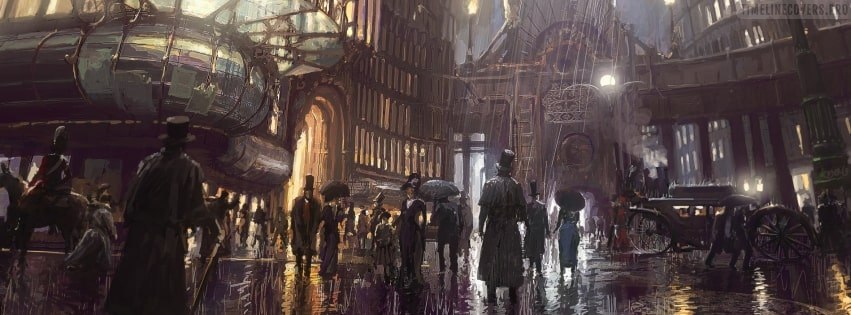
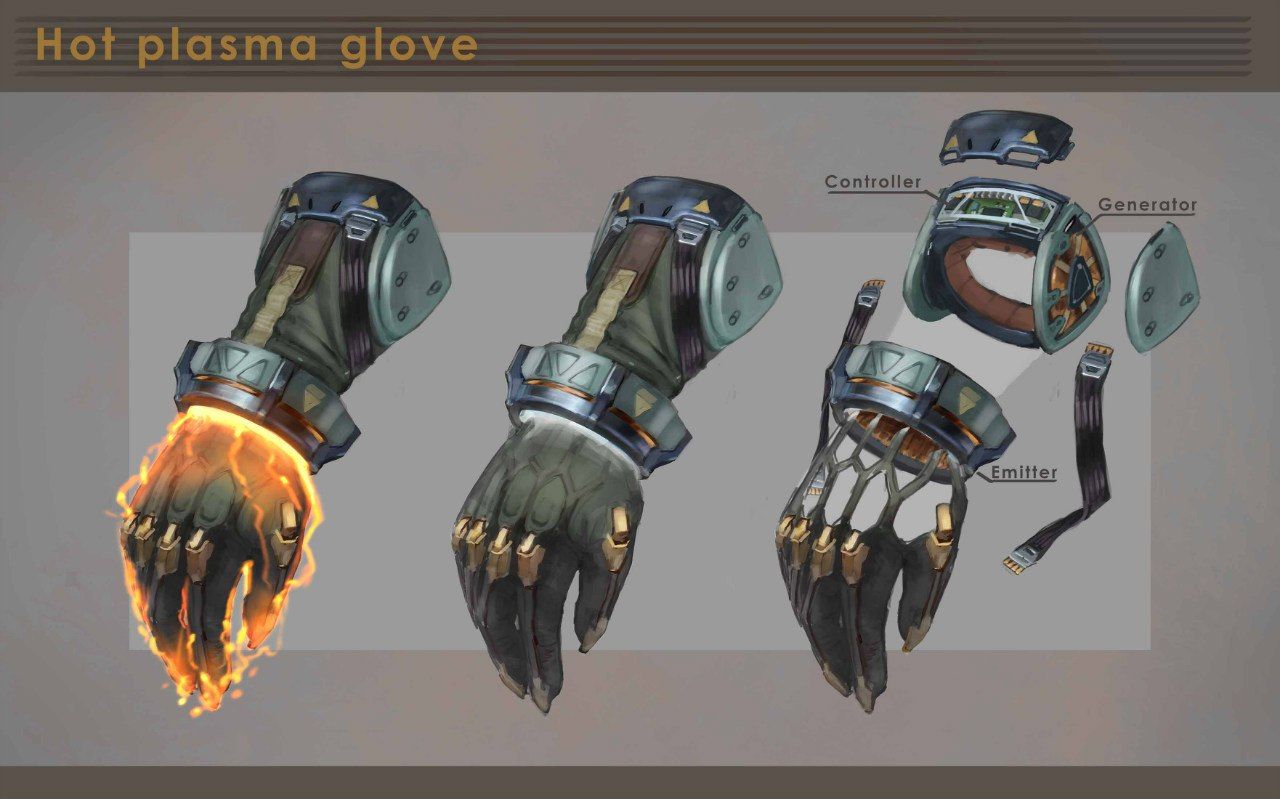
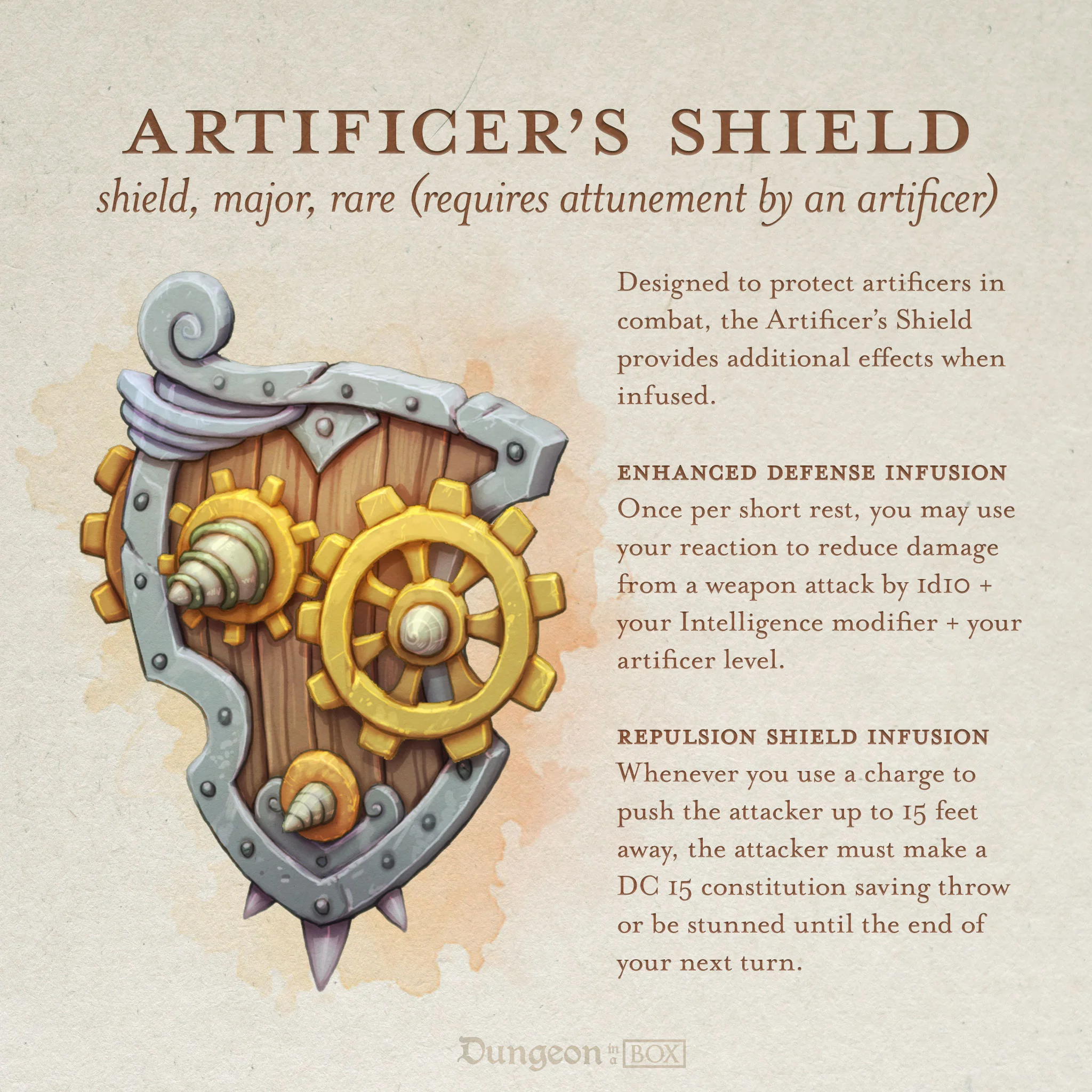
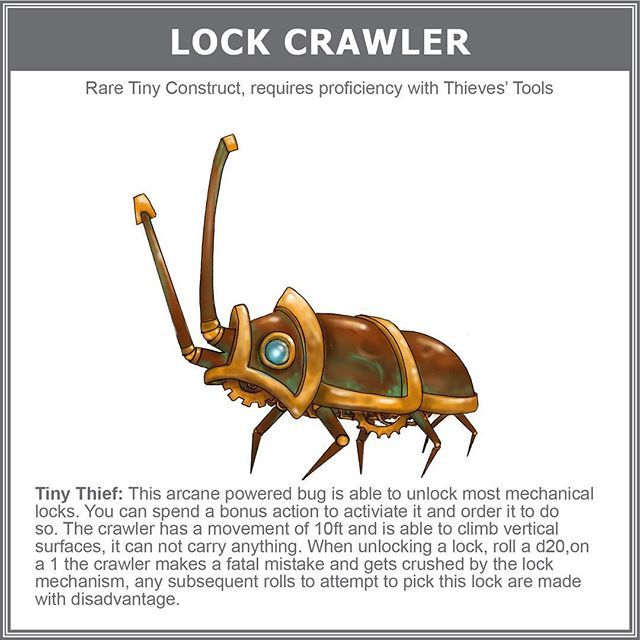
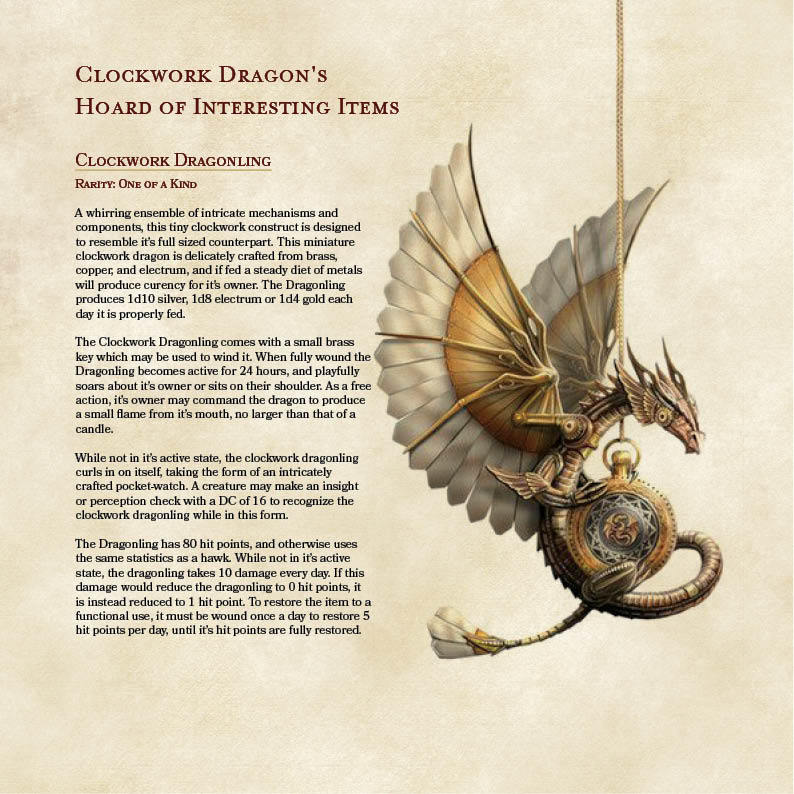
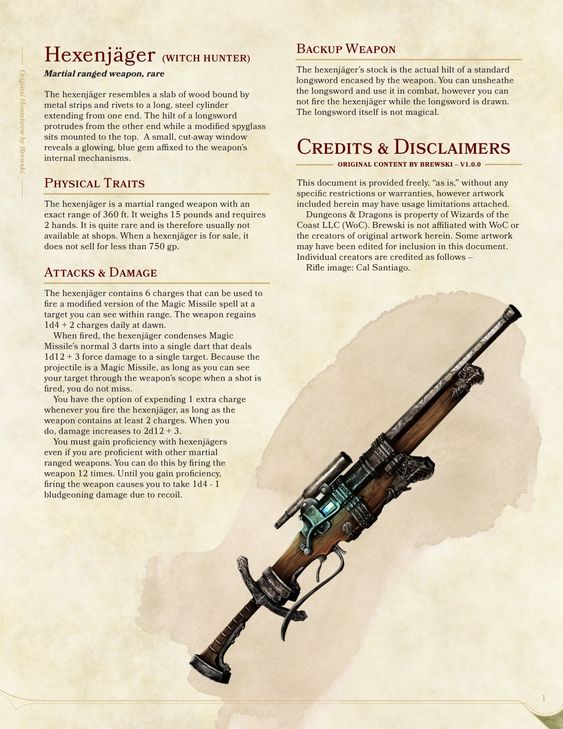
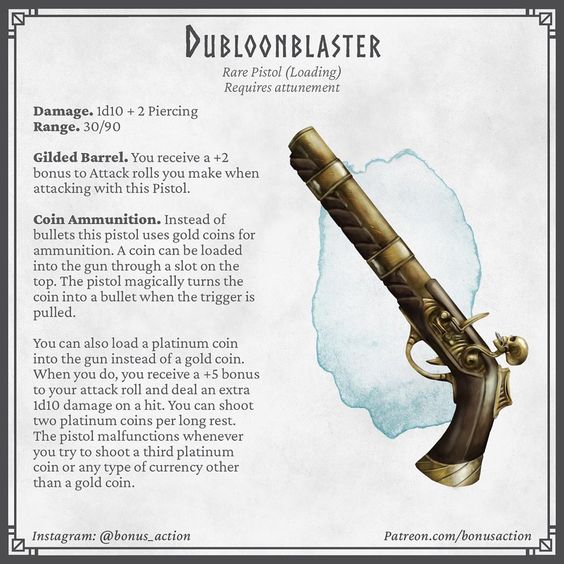
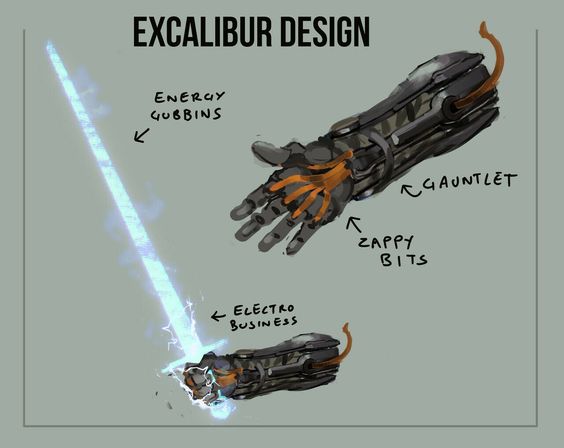
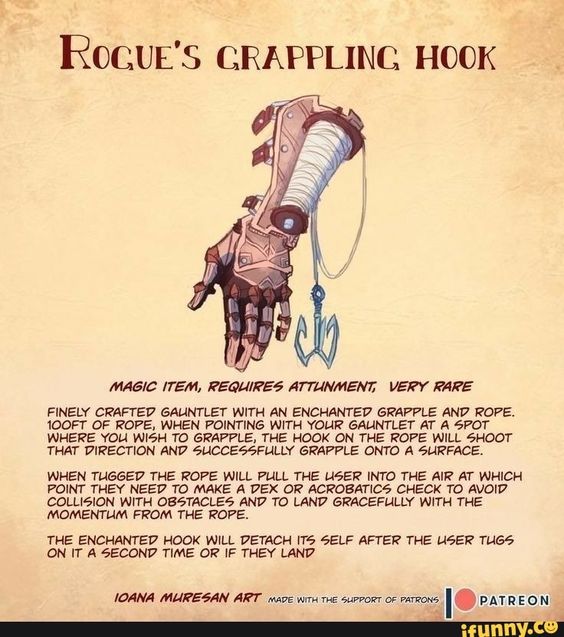
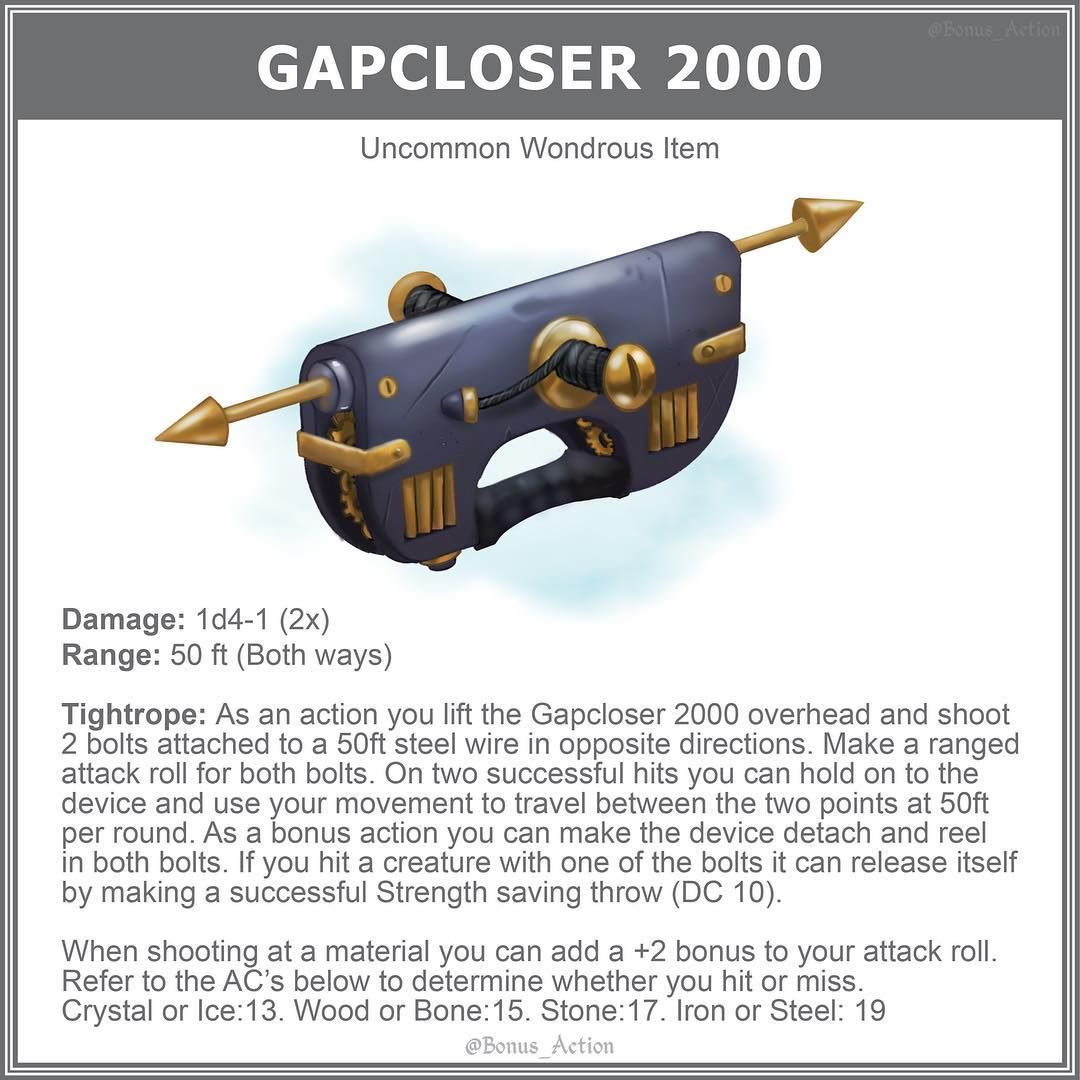







Comments